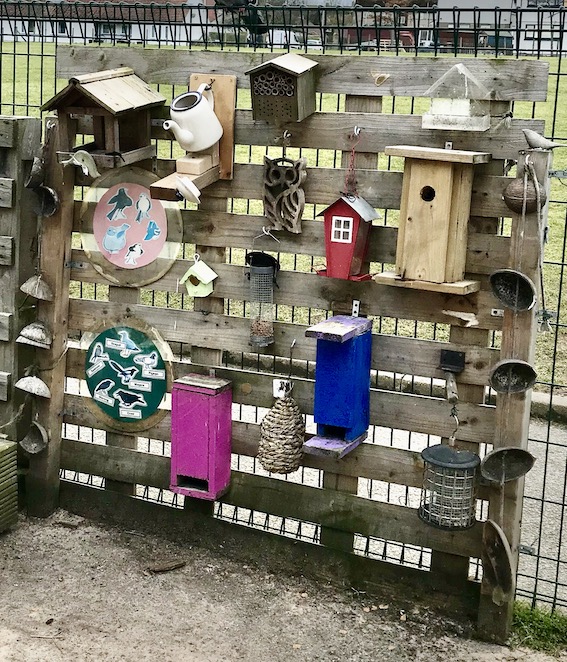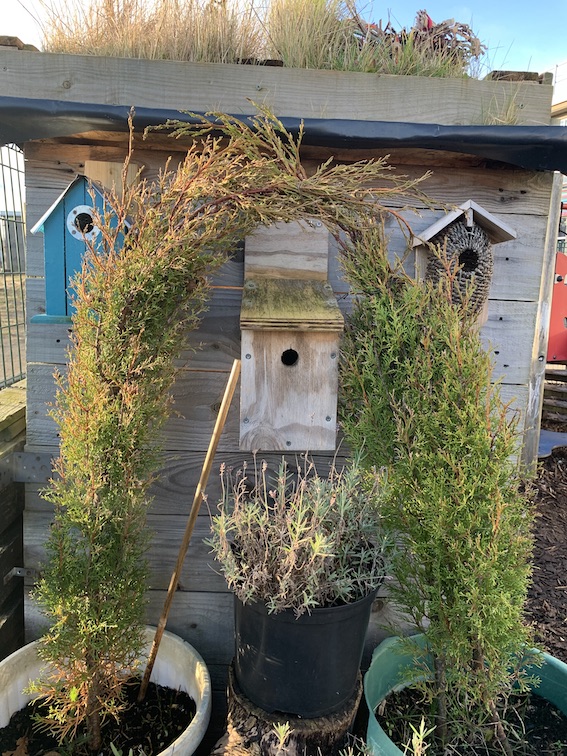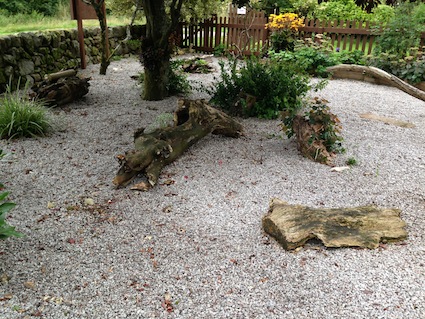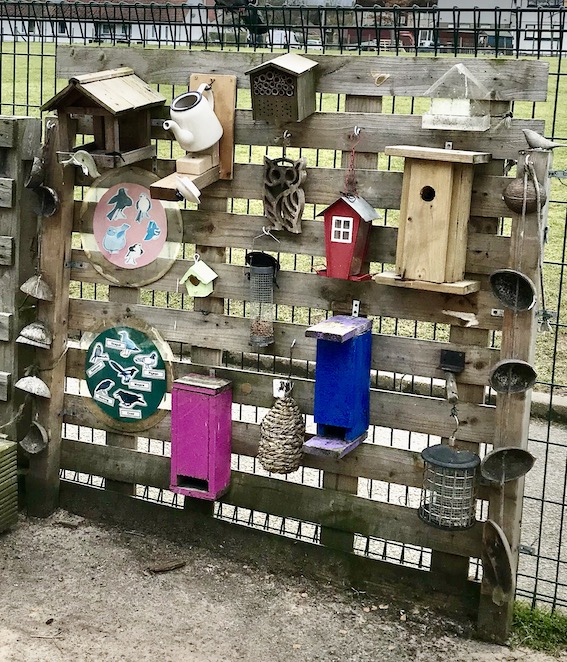The RSPB Big Schools’ Birdwatch is running again from 6th January until 20th February 2023. You can register to participate and download many free resources and advice about making this wonderful Citizen Science project a brilliant, direct learning experience for your class.

This post provides some ideas and activities for developing children’s interests in birds. It is a shared effort between Claire Marsden, a former local RSPB officer and myself. It is a very positive focus in that:
- There is need to spend oodles of money on resources. Mostly it is about using what is readily available.
- It is an opportunity to model respect for other species, to value their role and consider how they enrich our lives, as well as help them through the provision of food, shelter and water.
- Birds are also are source of fascination and can help develop empathy with other animals and sense of being part of a bigger family.
- Many aspects of the science curriculum can be learned through a focus on birds. Children and young people of all ages and abilities often enjoy thinking and learning about birds. See below.

Learning through birds
Children learn to identify and name a variety of common birds that they see in their local area. This includes learning about concepts such as:
- Carnivores, herbivores, insectivores and omnivores as they find out what different birds eat.
- Being able to describe birds accurately through recognising the different parts of birds: their structure and specific characteristics (i.e. what makes a bird a bird)
- The life cycle of different birds – they have offspring which grow into adults.
- The basic needs of birds for their survival and how we can change or modify our outdoor environments to make them more nature (and therefore bird) friendly.
- That birds need the right types and amounts of nutrition – they cannot make their own food – they get nutrition from what they eat.
- Birds are part of complex ecosystems. We can learn more about these through learning about food chains and webs that different birds are part of – identifying which ones are predators and which are prey and which may be both!
- Biodiversity: differences and similarities within and between species as well as across different ecosystems.
Starting Out
Birds are one of the most satisfying forms of wildlife because they are easy to find and observe unlike most native mammals. Most school grounds in Britain will have a variety of feathered visitors after every break and lunch time who are ready to pick over the leftover snacks and crumbs dropped on the ground. Thus children notice this and it’s interesting to hear their thoughts and opinions as to whether these visitors are welcome – or not!
Another starting point may be a child’s story from home or a book about a bird chosen to be read aloud during story time. Occasionally there are exciting bird happenings at school such as a nesting bird which can spark an interest.
From these discussions, there can be many possible practical outcomes, e.g.
- Watching birds, in the school grounds and local area
- Feeding birds and providing water
- Making the outdoor space or school grounds a bird friendly place
Home links
It is worth finding out if any families or staff are members of the RSPB or who are keen bird watchers. Perhaps they will be willing to visit the nursery, share their tips and be interviewed. Likewise there may be people in the local area that keep birds, e.g. ducks, geese, hens, pigeons, doves, budgies, etc. It may be possible for a group of interested children to visit.
It is also worth sharing and celebrating two events. The RSPB Big Garden Bird Watch happens on the last weekend of January and is an opportunity for families to enjoy bird watching at home and contribute to the nationwide survey. The RSPB Feed the Birds day happens at the end of October as a timely reminder to remember our feathered friends over the winter.
Bird activities indoors
- What do birds eat and do all birds eat the same food? Make bird seed cake and other healthy tasty treats for birds. With a group of children, you can create a sequencing book of instructions about how to do this. Bake a cake or other recipe for children to eat at snack to allow for comparative discussions.
- Play a variety of bird identification games. An online search, e.g. “RSPB bird ID games” will provide many links.
- Have a variety of books, poems, rhymes and songs available on bird themes. Jan White, founder of Early Childhood Outdoors created this blog post about bird books which a useful starting point.
- Have bird sounds available for children to hear. Encourage the children to think of ways of copying or making the same sound with different musical instruments or mimicking them with their own voices. Bird apps are particularly useful here. Be aware that some birds such as Great Tits and Song Thrushes have many different call sounds. Birds also communicate through body language.
- If you have a window at a suitable height, then set up an indoor bird hide. This works well if you can have a bird feeding station close to the window. This can take longer for birds to visit if they can see movement through the window.
- Enjoy various art activities around birds from using feathers, to drawing pictures of birds and creating interesting sculptures.
- Consider creating life-size outlines of different birds. This gives children a better idea just how big an eagle’s wingspan actually is!
- If your children are older, then more substantial projects can happen. Have a look at the Ducks at The Coombes School post.
- Add various bird artefacts to the nature table for children to freely examine and explore – encourage children and their families to add to this.
Bird activities in the outdoor space
- Get some hay, fleece (sheep’s wool), dried grass, dog hair, sticks and twigs so that children can create their own nests – big enough to fit themselves or small enough for a soft toy bird.
- Your children may wish to build a bird watching hide. Offer a range of materials and ensure that there’s a bird feeding station or nesting station nearby if this helps. Encourage the children to think about signs and information needed.
- Undertake some of these feather activities outside.
- Brainstorm with your children what they will need for bird watching. Have they any ideas or could we find out? This could included binoculars (homemade ones from decorated toilet tubes are popular), identification sheets (these could be hung up inside the hide), recording sheets on a clipboard, a dark coloured or camouflage jacket to wear. Have small scrap books for sketching birds that are seen.
- Weave natural materials into netting. These make super camouflage capes or can be hung up as part of a homemade bird hide.
- Make bird splat paintings on a big sheet or piece of dark coloured paper on the ground! Look at the colours in bird splat (but do not touch) and let the children try mixing up paints to create the colours seen. Often there is quite a variety in splats and this can be quite fascinating to record. Have a look at Nick Neddo’s Organic Artist for Children for ideas for creating shades of white using natural materials rather than classroom paint. If you live in an urban area, then challenge children to find bird splat in their local neighbourhood. Where is it commonly found and why? For example, often it can be found on the ground underneath lamp posts.
- Show children how to make bird gliders to fly outside. Sheets are available from an online search. Alternatively, perhaps children can learn how to make a basic glider which can be adapted to a bird shape. This can lead into discussions about flight and physics.
- Make up nest boxes. Ask a local RSPB officer for advice on the most suitable types and locations. Different species of bird need different types of boxes in different places. There is also lots of advice on helping birds on the RSPB website.
- Remove litter from your outdoor space and school grounds as this can harm birds and other wildlife.

Watching birds
- There are several different games you can play to help children learn how to approach and behave in a bird hide. It can also be fun for children to mimic different habits and characteristics of certain birds such as how they hear, see and move
- Have a range of binoculars – homemade or real – for the children to experiment with. In the past I’ve given children a choice over what equipment to use and very often children prefer the homemade binoculars. It’s also worth offering the option of using one or two tubes to look through.
- Have fun with identifying and counting the numbers and species of birds which come and visit. It can be interesting to see how the numbers grow as more birds learn that food is there for them

Bird activities off-site
Where do the children think that they will see most birds? Brainstorm different ideas. Show the children photos of different places in the local area. Let them chose which place to visit. There may be a nearby RSPB or nature reserve to which you can take the children. Make sure children know how to behave and approach a hide quietly before the visit. Afterwards compare the birds you have seen off-site with those that visit your school or setting.
Making the outdoor space a bird friendly place
A good starting point here is to ask children what they think birds need to stay alive. This might produce a variety of opinions. However it is likely that food, water and shelter will come up in some shape or form. Show the children photos of different garden birds and talk about where they like to nest and the food they like to eat.
From here, take a basket of toy birds or puppets outside and ask each child within a small group to put a bird in the place they think would be the best place for the bird to build a nest. Do not worry if your outdoor space is completely barren of plants. Ask the children to explain their decision to the rest of the group. Encourage them to consider the need for shelter, food and water.
Birds need a biodiverse environment. The more native plants and trees that are present the better. These plants attract insects and bugs which the birds can eat. The Wee Green Fingers blog post gives suggestions here. Forvie Tree Nursery, near Peterhead, run by Bob Davis can provide advice and trees for a very good price locally. Other measures schools and nurseries can take include:
1) Planting fruit trees and shrubs. As well as providing snack food and foraging opportunities for children, birds also appreciate the insects, fruit and berries.
2) Ensuring there is a supply of rainwater for birds to drink and bathe in. Ponds are best and can be a variety of sizes. See the blog post about Ponds in Schools for more information. Water butts are also helpful for collecting rain water. Children can experiment with seeing which types of bowls and water containers birds prefer.
3) Wetland areas are also helpful and there are many beautiful marsh-loving plants which grow here. This is a great project for naturally boggy areas of the school grounds.
4) Long grass is good for insects. Make arrangements with the landscaping services to leave swarths of grass to grow long. This can be done in interesting curves and shapes which can add interest to an outdoor space. Meadows are beautiful and can be created with careful cutting regimes. If your school grounds have enthusiastic mowers, then consider fencing off the areas of long grass in order to keep them long.
5) Log piles. Whilst there is a growing trend for creating minibeast hotels which is a very interesting project for re-using unwanted items, nothing beats a good old-fashioned log pile. Have big logs in the centre which should remain undisturbed with smaller logs available around the edges for children to turnover and look under.
6) Compost bins work well as they create a plentiful supply of worms which many garden birds enjoy.
7) Wildlife corridors are hedges, trees and plants that link up natural patches. A log pile in a container in the middle of a piece of tarmac will not get many insects coming along. But if it is positioned under a tree or beside a hedge then this will be more successful. It is also important for bird feeding stations to be located near a hedge, tree or shrub that can provide shelter and protection from predators such as cats.
8) Grow wildflowers. Generally small plant plugs grow more successfully especially in places where the seeds are competing with grass. Seeds are best scattered on rough soil rather than smoothly raked borders. Mixed wildflower seed packs are also available but some people find that these are not as successful as sowing single types of flower. The Wee Green Fingers blog post gives suppliers of native seeds and plant plugs.
9) Garden organically. Try to avoid using chemicals. There are many clever ways to deal with pests and issues that do not use pesticides, etc.
Tricky bird issues
The RSPB run a wildlife advice line which anyone can use to ask questions about issues or matters arising around birds. Phone: 01767 693690. Here’s some common examples:
Gulls are a nuisance in our playground
Take a problem solving approach. Ask the children why the gulls are there and talk about their adaptability. Next ask the children what they can do about the gulls? Very often gulls are in grounds because of the leftover food and litter from playtimes. It’s also interesting in that herring gulls who often frequent school grounds are on the UK red list owing to their recent rapid decline in numbers. Thus it is worth thinking about the role of schools in conserving this species.
A bird has made a nest in our school grounds in an unsuitable place
If appropriate, make some signs warning people to avoid the area until the chicks have hatched. If that is not possible, the next will probably fail due to disturbance, and the birds may try to nest again elsewhere.
What do we do if we find a bird’s egg on the ground?
If it is one the ground, it will either be broken or will have become too cold to hatch. Tidy it away, or leave it for other birds to scavenge.
Can we touch or take eggs from a nest?
All birds, their nests and their eggs are protected by the law. So, it is illegal to disturb, destroy or take nests from an active nest. Once the chicks have fledged from the nest, and it is no longer being used, it is possible to go and investigate the nest.
Are feathers safe to collect outside?
Yes! It is fascinating to collect different feathers to examine them and find out how they work. There are also some fun activities you can do with feathers. always remember to wash your hands after any outdoor foraging.
Do we only feed the birds in winter?
Winter is when the birds need our help most as their natural food sources become scarce, but it is perfectly alright to feed birds all the year round. Always remember to have a source of fresh water available too.
Where can I find out more information?The RSPB website has lots of information and advice about birds or you can phone your local RSPB office. Also look at the Scottish Ornithologists Club and the Wildfowl and Wetlands Trust

Feeding birds and providing water
There are lots of options for feeding birds aside from providing commercially bought food. Children can have fun designing their own bird food recipes from ingredients such as suet, seeds, apples, pears, brambles and plums (British fruit), cheese, cooked rice, soaked raisins. It can also be fun to provide snack food that contains some of these ingredients too!
It’s tempting to buy commercial feeders. However, there is a growing recognition that natural landscapes are more conducive for birds feeding as exemplified by this blog post about a natural feeding station (see above photo). It also more environmentally friendly. Local RSPB reserves often have excellent examples using natural materials that are usually free or found.
If you do this, remember they will need cleaned regularly – ideally weekly – to avoid the build up of old food that becomes toxic to birds. Likewise water needs changed regularly – ideally daily. In the photo below, the nursery have built up their bird wall over many years, slowly adding items relevant to each cohort of children. The cleaning of the area is written into the risk benefit assessment and part of the Friday jobs. The RSPB has specific advice to help keep your garden birds healthy.

If you have thoughts, ideas, activities or blog posts that relate to birds, please do comment and add relevant links.
This blog post was originally published in May 2012.




















Great ideas & advice here Juliet and thanks for adding it to the outdoor play link up this week. The best think when we moved ot the new site was the amount of trees around us, it is wonderful for the children to be able ot hear birds when out playing. We have had wagtails & sparrows nest in the playground too!
Agreed – the more greenery you have in an outdoor space the more wildlife appears.
I’m looking forward to greening up a tarmac patch in a few weeks time.
Juliet you should visit Reflections nursery the next time you are in the south, they are a wonderful Reggio inspired nursery and the children were very interested in birds. They made over some time a giant birds nest, an incredible bird museum amongst other wonderful explorations. Very inspirational setting.
Thanks Sam – I have heard lots of positives about Reflections Nursery. Hopefully I’ll get there one day 🙂
Your excellent post reminded me about this children’s books collection I did for the RSPB Great Garden Birdwatch in 202. I had a beautiful Black Cap on my feeder yesterday (likes the suet balls most with that long beak).
https://www.earlychildhoodoutdoors.org/sharing-the-nursery-garden-with-our-birds/
Thank you Jan – I will add the link directly into the blog post as it’s so useful to have lists of books – my own was a very dated Listmania from Amazon which I felt was unsuitable and dated!